

Artist’s reconstruction of Chicxulub crater soon after impact, 66 million years ago. Image via Detlev Van Ravenswaay/ Science Source/ Science.
What was ancient life on Earth like? Scientists revealed on October 30, 2020, that they’ve discovered some important new clues. Interestingly, the evidence lies in Chicxulub (roughly pronounced ‘CHEEK-shu-loob’), a large, circular, buried impact crater thought by many to have formed in the asteroid collision event that killed the dinosaurs 66 million years ago. Earlier this year, scientists had discovered that Chicxulub once contained a vast hydrothermal system – a hot-water system – of hot mineral-rich water. Now the same team says it has found evidence for a subterranean ecosystem of microbial life, hosted by the crater and its hot water.
After the colossal impact that created the Chicxulub crater, Earth’s surface was pretty much uninhabitable. But the new work shows that impacts like Chicxulub produced niches underground where microbial life could flourish. Cool, yes?
The new peer-reviewed study comes from scientists at the Universities Space Research Association (USRA) in Washington, D.C., and the Lunar and Planetary Institute (LPI) in Houston, Texas. It was published online by the journal Astrobiology on October 30, 2020.
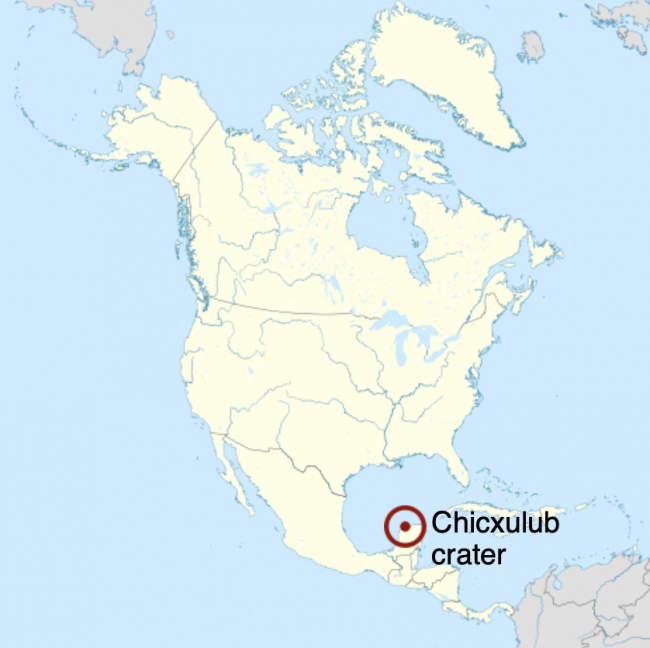
Location of Chicxulub crater via Wikipedia.
Chicxulub, about 119 miles (180 km) in diameter and located beneath the northern edge of the Yucatán Peninsula, Mexico, is one of the best preserved impact craters on Earth. Most craters have, of course, been eroded away by Earth’s water and atmosphere – unlike on airless bodies such as the moon which get to keep their craters – but Chicxulub still remains recognizable to its original form. It is also the best preserved impact crater similar to those from a period of heavy meteorite bombardment 3.8 billion years ago.
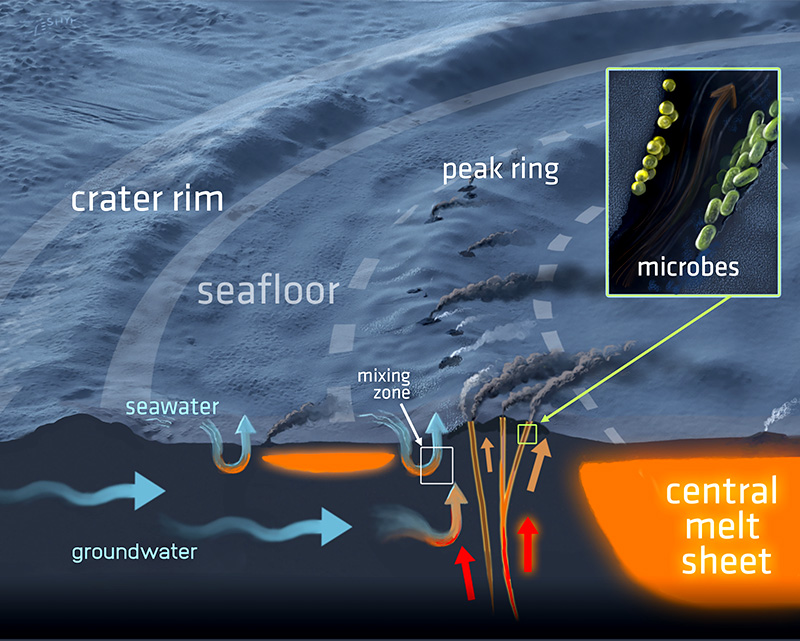
Cross-section of the ancient hydrothermal system in Chicxulub Crater. Researchers have found evidence for a thriving microbial ecosystem in the hydrothermal system about 3.8 billion years ago. Image via Victor O. Leshyk/ Lunar and Planetary Institute/ USRA.
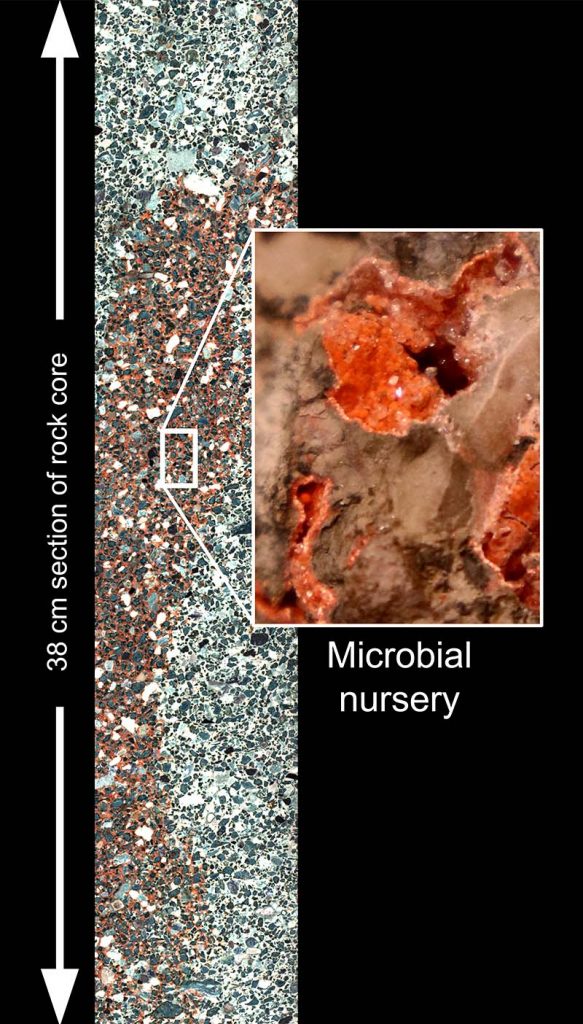
Chicxulub core sample containing the hydrothermal minerals dachiardite and analcime. These minerals helped support a thriving microbial ecosystem. Image via David A. Kring/ Lunar and Planetary Institute/ USRA.
Many large impacts occurred during this time, which is called the Hadean eon and is the oldest time period in the history of Earth (from 4.6 billion years ago – the beginning of Earth’s existence – to 4 billion years ago). Some of these impacts were even large enough to temporarily vaporize the oceans! The result was a hot, steamy, rock-vapor-filled atmosphere, making Earth’s surface uninhabitable at the time. But what about below the surface? Could life have existed there, in a more protected environment in subsurface hydrothermal systems? According to this new research, it could, and it did.
The scientist who led the new study, David Kring at LPI, put forward a concept called the Impact-Origin of Life Hypothesis. The concept was basically that hot, mineral-rich water could flow through rock fractured by the impact, creating a subsurface hydrothermal system that could support some kinds of microscopic life. The new findings show that such a system persisted for hundreds of thousands – or millions – of years beneath Chicxulub Crater, and may provide valuable clues as to how life first developed on Earth.
So how did the researchers discover this evidence?

David Kring at the Universities Space Research Association (USRA) and the Lunar and Planetary Institute (LPI), who led the new study. Image via USRA.
They obtained rock core samples from the peak ring of the crater, via an expedition supported by the International Ocean Discovery Program and International Continental Scientific Drilling Program. Fifteen thousand kilograms (33,000 pounds) of rock were recovered in total from a 0.8 mile (1.3 km)-deep borehole. When examined, tiny spheres of the mineral pyrite, only 10 millionths of a meter in diameter, were found. Analysis of sulfur isotopes (variations of sulfur with different numbers of neutrons in their atoms) within the mineral showed that the spheres were created by a microbial ecosystem. The microbes had adapted to the hot fluids in the hydrothermal system and flourished.
The microbes fed on chemical reactions that occurred within the system. When sulfate was converted to sulfide, it was preserved as pyrite, which the microbes used for energy. These organisms were similar to thermophilic bacteria (bacteria able to live at high temperatures) and archaea (single-celled microorganisms with a structure similar to bacteria who survive in environments low in oxygen) found today in hydrothermal systems such as those in Yellowstone National Park.
EarthSky reached out to Kring by email for additional comments on the significance of these findings.
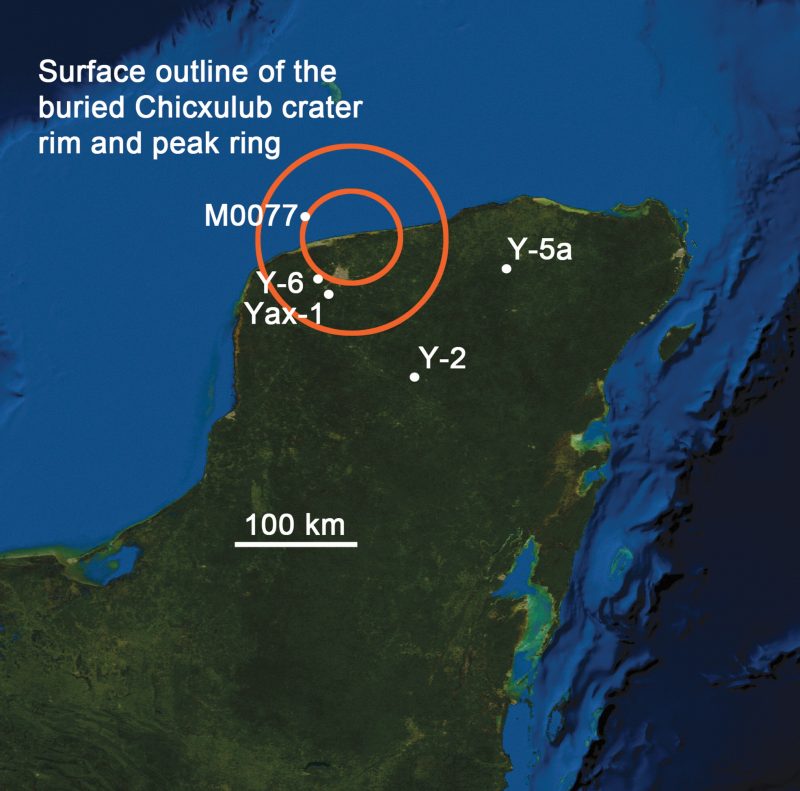
Surface outline of Chicxulub Crater as we see it today, beneath the northern edge of the Yucatán Peninsula, México. Image via Kring et al./ NASA/ Astrobiology.
ES: How did you first come up with the impact origin of life hypothesis?
DK: The impact origin of life hypothesis emerged from a conjunction of two independent studies. First, our group was trying to locate the impact site that extinguished dinosaurs. When I was studying our discovery samples, I realized that the impact rocks were overprinted by hydrothermal mineralization, indicating the impact generated a hydrothermal system. Second, at the same time, I was studying a period of intense early solar system bombardment that is sometimes called the lunar cataclysm, inner solar system cataclysm, or late heavy bombardment. Some of those impact events were so large that they vaporized Earth’s seas, making it impossible for life to exist on Earth surface. Putting one and two together, I realized those same impact events generated subsurface hydrothermal systems that would be perfect habitats for the early evolution of life. In parallel, biologists determined that the tree of life is rooted in organisms that lived in hydrothermal systems. Thus, it seemed plausible life arose from an impact crater.
ES: Are the sulfur-eating microbes the only ones known so far, or could other types of microbial life have also existed in the hydrothermal system? What about other types of (non-microbial) life?
DK: Sulfate-reducing microbes are the only organisms detected thus far, but other types of organisms may have existed in the hydrothermal system. We are beginning that search now.
ES: Are there any other semi-preserved impact craters that may have had similar hydrothermal systems?
DK: Yes, Haughton in Canada and Rochechouart in France.
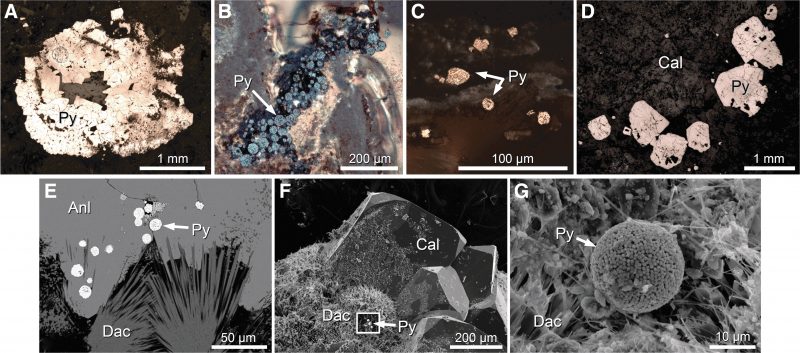
Microscopic image of sulfide grains and pyrite spheres in the core sample from Chicxulub Crater. Image via Kring et al./ Astrobiology.
ES: What further studies are planned for Chicxulub Crater?
DK: We are looking for additional organisms that may have thrived in the subterranean hydrothermal system. We want to define the entire ecosystem and examine how it evolved over several million years.
These findings are fascinating because they support the possibility that meteorite or asteroid impacts during the earliest age of Earth – the Hadean eon – could have helped life get started. And if it happened on Earth, could it have occurred elsewhere, such as on Mars, or the icy moons with subsurface oceans in the outer solar system, or even dwarf planets like Ceres (which, like most bodies in the solar system, is covered in craters, but also is now known to have had a layer of liquid water beneath its surface in its past, and maybe still does)? The possibilities are intriguing to contemplate!
Read more about the Impact-Origin of Life Hypothesis
Bottom line: Researchers have discovered evidence for an ancient microbial ecosystem in a hydrothermal system beneath the huge dinosaur-killing Chicxulub impact crater.
Source: Microbial Sulfur Isotope Fractionation in the Chicxulub Hydrothermal System
from EarthSky https://ift.tt/3p5MuvB


Artist’s reconstruction of Chicxulub crater soon after impact, 66 million years ago. Image via Detlev Van Ravenswaay/ Science Source/ Science.
What was ancient life on Earth like? Scientists revealed on October 30, 2020, that they’ve discovered some important new clues. Interestingly, the evidence lies in Chicxulub (roughly pronounced ‘CHEEK-shu-loob’), a large, circular, buried impact crater thought by many to have formed in the asteroid collision event that killed the dinosaurs 66 million years ago. Earlier this year, scientists had discovered that Chicxulub once contained a vast hydrothermal system – a hot-water system – of hot mineral-rich water. Now the same team says it has found evidence for a subterranean ecosystem of microbial life, hosted by the crater and its hot water.
After the colossal impact that created the Chicxulub crater, Earth’s surface was pretty much uninhabitable. But the new work shows that impacts like Chicxulub produced niches underground where microbial life could flourish. Cool, yes?
The new peer-reviewed study comes from scientists at the Universities Space Research Association (USRA) in Washington, D.C., and the Lunar and Planetary Institute (LPI) in Houston, Texas. It was published online by the journal Astrobiology on October 30, 2020.

Location of Chicxulub crater via Wikipedia.
Chicxulub, about 119 miles (180 km) in diameter and located beneath the northern edge of the Yucatán Peninsula, Mexico, is one of the best preserved impact craters on Earth. Most craters have, of course, been eroded away by Earth’s water and atmosphere – unlike on airless bodies such as the moon which get to keep their craters – but Chicxulub still remains recognizable to its original form. It is also the best preserved impact crater similar to those from a period of heavy meteorite bombardment 3.8 billion years ago.

Cross-section of the ancient hydrothermal system in Chicxulub Crater. Researchers have found evidence for a thriving microbial ecosystem in the hydrothermal system about 3.8 billion years ago. Image via Victor O. Leshyk/ Lunar and Planetary Institute/ USRA.

Chicxulub core sample containing the hydrothermal minerals dachiardite and analcime. These minerals helped support a thriving microbial ecosystem. Image via David A. Kring/ Lunar and Planetary Institute/ USRA.
Many large impacts occurred during this time, which is called the Hadean eon and is the oldest time period in the history of Earth (from 4.6 billion years ago – the beginning of Earth’s existence – to 4 billion years ago). Some of these impacts were even large enough to temporarily vaporize the oceans! The result was a hot, steamy, rock-vapor-filled atmosphere, making Earth’s surface uninhabitable at the time. But what about below the surface? Could life have existed there, in a more protected environment in subsurface hydrothermal systems? According to this new research, it could, and it did.
The scientist who led the new study, David Kring at LPI, put forward a concept called the Impact-Origin of Life Hypothesis. The concept was basically that hot, mineral-rich water could flow through rock fractured by the impact, creating a subsurface hydrothermal system that could support some kinds of microscopic life. The new findings show that such a system persisted for hundreds of thousands – or millions – of years beneath Chicxulub Crater, and may provide valuable clues as to how life first developed on Earth.
So how did the researchers discover this evidence?

David Kring at the Universities Space Research Association (USRA) and the Lunar and Planetary Institute (LPI), who led the new study. Image via USRA.
They obtained rock core samples from the peak ring of the crater, via an expedition supported by the International Ocean Discovery Program and International Continental Scientific Drilling Program. Fifteen thousand kilograms (33,000 pounds) of rock were recovered in total from a 0.8 mile (1.3 km)-deep borehole. When examined, tiny spheres of the mineral pyrite, only 10 millionths of a meter in diameter, were found. Analysis of sulfur isotopes (variations of sulfur with different numbers of neutrons in their atoms) within the mineral showed that the spheres were created by a microbial ecosystem. The microbes had adapted to the hot fluids in the hydrothermal system and flourished.
The microbes fed on chemical reactions that occurred within the system. When sulfate was converted to sulfide, it was preserved as pyrite, which the microbes used for energy. These organisms were similar to thermophilic bacteria (bacteria able to live at high temperatures) and archaea (single-celled microorganisms with a structure similar to bacteria who survive in environments low in oxygen) found today in hydrothermal systems such as those in Yellowstone National Park.
EarthSky reached out to Kring by email for additional comments on the significance of these findings.

Surface outline of Chicxulub Crater as we see it today, beneath the northern edge of the Yucatán Peninsula, México. Image via Kring et al./ NASA/ Astrobiology.
ES: How did you first come up with the impact origin of life hypothesis?
DK: The impact origin of life hypothesis emerged from a conjunction of two independent studies. First, our group was trying to locate the impact site that extinguished dinosaurs. When I was studying our discovery samples, I realized that the impact rocks were overprinted by hydrothermal mineralization, indicating the impact generated a hydrothermal system. Second, at the same time, I was studying a period of intense early solar system bombardment that is sometimes called the lunar cataclysm, inner solar system cataclysm, or late heavy bombardment. Some of those impact events were so large that they vaporized Earth’s seas, making it impossible for life to exist on Earth surface. Putting one and two together, I realized those same impact events generated subsurface hydrothermal systems that would be perfect habitats for the early evolution of life. In parallel, biologists determined that the tree of life is rooted in organisms that lived in hydrothermal systems. Thus, it seemed plausible life arose from an impact crater.
ES: Are the sulfur-eating microbes the only ones known so far, or could other types of microbial life have also existed in the hydrothermal system? What about other types of (non-microbial) life?
DK: Sulfate-reducing microbes are the only organisms detected thus far, but other types of organisms may have existed in the hydrothermal system. We are beginning that search now.
ES: Are there any other semi-preserved impact craters that may have had similar hydrothermal systems?
DK: Yes, Haughton in Canada and Rochechouart in France.

Microscopic image of sulfide grains and pyrite spheres in the core sample from Chicxulub Crater. Image via Kring et al./ Astrobiology.
ES: What further studies are planned for Chicxulub Crater?
DK: We are looking for additional organisms that may have thrived in the subterranean hydrothermal system. We want to define the entire ecosystem and examine how it evolved over several million years.
These findings are fascinating because they support the possibility that meteorite or asteroid impacts during the earliest age of Earth – the Hadean eon – could have helped life get started. And if it happened on Earth, could it have occurred elsewhere, such as on Mars, or the icy moons with subsurface oceans in the outer solar system, or even dwarf planets like Ceres (which, like most bodies in the solar system, is covered in craters, but also is now known to have had a layer of liquid water beneath its surface in its past, and maybe still does)? The possibilities are intriguing to contemplate!
Read more about the Impact-Origin of Life Hypothesis
Bottom line: Researchers have discovered evidence for an ancient microbial ecosystem in a hydrothermal system beneath the huge dinosaur-killing Chicxulub impact crater.
Source: Microbial Sulfur Isotope Fractionation in the Chicxulub Hydrothermal System
from EarthSky https://ift.tt/3p5MuvB

Aucun commentaire:
Enregistrer un commentaire